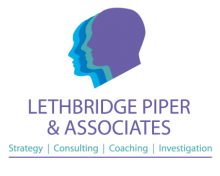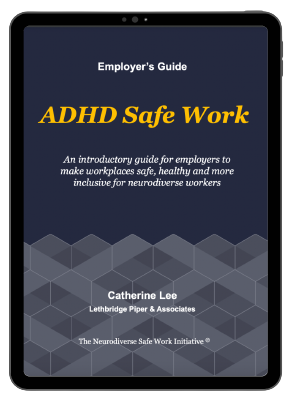Neurodiverse Safe Work Initiative ©
Are you an employer?
Are you working in HR or OHS?
Do you have employees with ADHD, Autism Spectrum Disorder or other neurodivergent traits?
Do you want to know how best to keep them safe and performing well?
Neurodivergent workers may experience risk at work differently from their neurotypical co-workers, so your OHS Management System needs to be flexible. Every person is different and every workplace is different, so you may need to work with the individual to create an individualised safe work plan.
BUT HOW?
Lethbridge Piper & Associates is an Australian Occupational Health and Safety Management Consultancy with a difference. Specialising in neurodiversity, we work with Boards, Executive and Leadership Teams to support you in creating workplaces that are safe, healthy and inclusive of your neurodiverse workforce.
The Worker
Kyle (not his real name!) is 23. He’s been
a production worker for his current employer since he left school at 17.
The Employer
Queensland manufacturing company with 85 workers across two shifts.
The Incident
Kyle had a fall at work and fractured his coccyx. His employer could not
identify the root cause of the incident.
Background
This wasn’t the first time Kyle had been involved in an incident. In the last four months, Kyle has had a few minor accidents and he has been making operational mistakes.
After an operational error that caused a loss of product, Kyle’s supervisor tried to talk to him about what had gone wrong and gave him a warning. Kyle blew up at him and walked off the job. This resulted in him getting a second warning from HR the next day. This is all out-of-character for Kyle.
Catherine was asked to investigate the most recent incident to see if she could find out why Kyle had fallen and also to whether there was any underlying issue to explain the change in his behaviour and performance.
Investigation Findings
There were no obvious slip/trip hazards, the lighting was good and Kyle was wearing good non-slip work boots. Looking at the CCTV footage with Kyle, he explained that there was an obstruction on the conveyor that he needed to fix, but he forgot to turn the line off and when he quickly turned to rush back to the head of the line, his feet went from under him and he landed heavily.
Kyle told Catherine that he was just rushing and not paying attention. He said he felt overwhelmed and stressed out because of the warnings. He blamed himself and said he felt stupid. He was certain at this point he was going to lose his job.
Catherine pointed out to him that he’d been doing this job for 6 years and he was good at it. He must have cleared obstructions on the line hundreds of times. What was different about it this time? Why was he feeling overwhelmed and stressed?
Eventually Kyle told Catherine that when he was 11 years old he had been diagnosed with ADHD. He had taken Ritalin ever since but he didn’t really think it affected him anymore.
When his employer introduced a Drug and Alcohol Policy that meant all workers could be randomly screened at work, he decided to stop taking the Ritalin because he “didn’t want to get busted”. He assumed he’d grown out of his ADHD and didn’t need the medication any more. He had not discussed this decision with his doctor.
The root cause of Kyle’s fall was far more complex than a simple slip or trip hazard. Because Kyle had stopped taking his medication, the symptoms of ADHD had returned. He was feeling more hyperactive and restless, was finding it hard to concentrate on the essential record keeping tasks and had been making mistakes. He wasn’t paying attention to the hazards in his environment and was constantly feeling overwhelmed and irritable.
The reason Kyle stopped taking his medication, and the root cause of the incident, was that he had never been informed and did not understand his rights and responsibilities under the Drug and Alcohol Policy. He assumed he’d grown out of his ADHD and didn’t need the medication anymore. He didn’t want to tell his employer about it because he didn’t want to be judged and was worried he’d lose his job.
The ND Safe Work Solution
The OHS Management System Approach
Catherine recommended the following systemic actions:
1. Review of the Drug and Alcohol Policy to make sure that it complied with the relevant Australian Standard, was revised in consultation with workers, and that all staff would be educated in why it was necessary, how it would be implemented and what procedure would be followed in the event a worker returned a “non-negative” result.
2. Review of the OHS Management System – Consultation and Communication Policy and Procedures to ensure workers are engaged in informed.
3. Review of the OHS Management System – Risk Management Policy and Procedures to accommodate neurodivergent workers and workers with disabilities.
4. Review of HR Policies to accommodate neurodivergent workers.
The Person-Centered Approach
(ND Safe Work Plan)
With Kyle’s consent, Catherine wrote to his Psychiatrist and advised that Kyle’s ceasing medication had impacted his performance and safety at work and asked for the Psychiatrist’s advice and support to manage the newly identified risks for Kyle at work. Kyle made an urgent appointment to see the Psychiatrist and recommenced medication. A collaborative and productive relationship was established between Catherine, Kyle and his psychiatrist.
In the meantime, Catherine advocated with the employer to pause any further disciplinary action while Kyle addressed adjusted to his medication and coached Kyle to identify all the areas in his work (and life) that were now impacted by his ADHD since he had ceased his medication and to identify the specific parts of his job that were, for now, a higher risk for him. Kyle set some personal and work-related goals and committed to getting his life back on track.
When Kyle was physically fit to return to work after his fractured coccyx had healed, together with his supervisor, Kyle and Catherine designed a Safe Work Plan that:
1. temporarily relieved him from tasks that he was not able to focus on;
2. allocated tasks that would keep him active and interested;
3. set up a buddy system with a co-worker to provide support
4. provided additional support/checking in the areas where he was challenged such as administration and record-keeping and remind him when his break was due and make sure he took it because Kyle was inclined to lose track of time, and;
5. temporarily allocated only afternoon shifts while Kyle readjusted to medication.
The plan was reviewed and upgraded incrementally as Kyle adjusted to his new medication and practiced new coping skills.
Conclusion
After 6-months Kyle was working his normal duties again and had taken on the role of Workplace Health and Safety Representative on the newly established OHS Committee.
He wants to give that Committee a different perspective about health and safety at work. He’s also enrolled in a Mental Health First Aid course which his employer is committed to supporting.

Have you noticed some of these characteristics in your employees?
- Distractibility
- Impulsivity
- Hyperactivity.
- Difficulty managing long-term or complex projects.
- Boredom.
- Poor working memory.
- Procrastination.
- Hyperfocus.
- Time blindness.
- Interpersonal/social skills.
- Fatigue.
Are you reading this and someone who works for you instantly jumps in your head and has you questioning if they could have ADHD? However, not only are you unsure how to support them, you don’t even understand ADHD to know what your employee is dealing with.
Look no Further. We can assist!
In our FREE ebook ADHD Safe Work, we provide you with important information to assist you in supporting your employees and understand how they work.
ADHD SAFE WORK
An introductory guide for employers to make workplaces safe, healthy and more inclusive for neurodiverse workers
This ebook will provide you with information about neurodiversity and why it’s important to understand both the benefits and the risks.
Covering topics such as:
- ADHD – the facts
- What does this mean for employers
- The OHS Management Systems Approach
- The Person – Centered Approach
We will discuss the negative impacts of untreated ADHD, supporting those on medication for ADHD and how you can create a positive and inclusive safety culture for workers with ADHD or any neurodivergent condition.
This short, 25 page ebook, which is packed full of tips and recommendations, will give you a much better understanding of neurodiversity, and particularly ADHD to help you manage the safety and health at work of all your workers.
WHO IS CATHERINE LEE?

Catherine Lee is the author of the “ADHD Safe Work”, which she allows reader to have knowledge of neurodiverse workers and make workplaces safe, healthy and more inclusive for these workers.
“ADHD Safe Work” provides advice and support on the development of a health and safety management system that embraces the diverse range of skills, abilities, and challenges that exist within every neurodiverse workforce.
She has more than 30 years experience across a range of industries both in Australia and the UK, Occupational Health and Safety Management Consultant, Catherine Lee partners with leadership teams, supporting them in achieving their strategic OHS objectives.
Catherine is a full member of the Australian Institute of Company Directors and Institute of Management Consultants and a Certified Professional Member of the Australian Institute of Health and Safety. Catherine is accredited by the Office of Industrial Relations as a WorkCover self-insurance auditor and is a Member of the International Coaching Federation and a Professional Member of the Attention Deficit Disorder Association.
With her qualifications and extensive experience, Catherine has achieved outstanding results for our clients in the areas of OHS management systems auditing, incident and claims investigation, complex case management, conflict resolution, mediation, health promotion, professional coaching, and mentoring. Working with Catherine, clients have been able to:
- Make tangible improvements to their workplace culture by focusing on worker engagement, consultation, and negotiation;
- Implement systems for the early identification and management of risks to the health and wellbeing of workers; and
Reduce their workers’ compensation costs through injury prevention and management programs, proactive and complex case management, and self-insurance.
Most recently, recognising that employers are generally not realising the benefits or recognising and managing the risks for neurodiverse workers, Catherine has created the Neurodiverse Safe Work Inititiatve which is designed to raise awareness and educate employers about the benefits of embracing neurodiversity and provide tools and techniques to assist employers in adapting their health and safety management systems to accommodate the different ways that all workers think, learn, process, and retain information, regulate emotions and attention, perceive and respond to risk.
My Address
PO Box 502
North Lakes Qld 4509
Phone
admin@lethbridgepiper.com.au
Book in for a chat!
Subscribe for news & updates.

